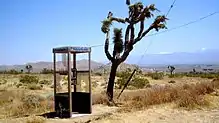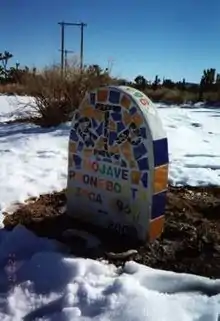Mojave phone booth
The Mojave phone booth (/moʊˈhɑːvi, mə-/ mo-HAH-vee[1]) was a lone telephone booth in what is now the Mojave National Preserve in California. It attracted online attention in 1997 for its unusual location – it was located at the intersection of two dirt roads in a remote part of the Mojave Desert, 12 miles (19 km) from the nearest paved road (Interstate 15 to the northeast, Kelbaker Road to the southwest) and miles from any buildings.
| No. issued | +1 (760) 733-9969 |
|---|
| Mojave phone booth | |
|---|---|
 Former site Location within California | |
| General information | |
| Status | Removed May 17, 2000 |
| Type | Phone booth |
| Location | Mojave National Preserve, San Bernardino County, California |
| Country | United States |
| Coordinates | 35.285827°N 115.68463°W |
| Inaugurated | 1960s |
| Owner | Pacific Bell |
History


The phone booth was originally set up in 1948 to provide telephone service to local volcanic cinder miners and others living in the area, at the request of Emerson Ray, who owned the Cima Cinder Mine nearby.[2] It was assigned the name Cinder Peak Policy Station, part of a network of "policy stations" placed by mandate of the California government to serve residents of isolated parts of the state. The Mojave phone booth probably replaced an earlier booth 30 miles (48 km) to the south.[3] The original hand-cranked magneto phone was replaced with a payphone in the 1960s.[2] The rotary phone was then replaced with a touch-tone model in the 1970s.[3] The booth phone's original number was BAker-3-9969. After area codes were established in 1947, it shared the same area code as all of Southern California, 213. In 1951, the area code 714 was split off from 213, and 714 was the booth's area code until 1982 when parts of Riverside and San Bernardino counties were given the area code 619. The booth's area code for its final few years of existence was 760.[4]
In 1997, a Los Angeles man spotted a telephone icon on a map of the Mojave Desert and decided to visit it. He wrote a letter about his adventure to an underground magazine and included the booth's telephone number. An Arizona man, Godfrey Daniels, read the letter and started a website devoted to the Mojave telephone booth.[4] The booth became an Internet sensation after it was mentioned in a New York Times article.[5] Soon other people began calling the booth, others made websites about it, and a few even took trips to the booth to answer, often camping out at the site. Several callers kept recordings of their conversations. Over time, the booth became covered in graffiti left by visitors.
Removal
The booth was removed by Pacific Bell on May 17, 2000, at the request of the National Park Service. Per Pacific Bell policy, the phone number was retired. Officially, the removal was because of visitors' environmental impact on the national preserve,[3] and a letter by the Mojave National Preserve's superintendent mentions confronting Pacific Bell with some long-forgotten easement fees.[6] A headstone-like plaque was later placed at the site, but it too was eventually removed by the National Park Service. Fans of the booth feared that Pacific Bell had destroyed the booth,[7] which was confirmed by Pac-Bell spokesperson Steve Getzug.[4]
The story inspired the creation of an independent short film, Dead Line, a short documentary, Mojave Mirage, and a full-length motion picture, Mojave Phone Booth.[3] The booth was also an inspiration for the prologue of the Glenn Beck novel The Overton Window, and is the subject of a 99% Invisible podcast episode, "Mojave Phone Booth".[8] In 2018, Adventures with the Mojave Phone Booth was published, a full-length book chronicling the booth's history, rise to fame, destruction, and aftermath.[4]
Revival of the phone number
AT&T's PacBell no longer owns the Baker, California +1-760-733-9XXX block of one thousand numbers, having relinquished it to competitive local exchange carrier peerlessnetwork.com on March 28, 2013, as part of a number pooling scheme.[9] The Mojave phone booth's number, 760-733-9969, was acquired from the CLEC by phone phreak Lucky225 on July 31, 2013, and now rings using voice over IP to a conference he and Teli Tuketu set up, as well as a text based IRC-like chat.[10][11] Callers join a conference where strangers can once again connect just like when the phone booth was active.[10]
References
- Jones, Daniel (2003) [1917], Peter Roach; James Hartmann; Jane Setter (eds.), English Pronouncing Dictionary, Cambridge: Cambridge University Press, ISBN 978-3-12-539683-8
- Nystrom, Eric Charles (2003). "Chapter 6". From Neglected Space to Protected Place: An Administrative History of Mojave National Preserve. National Park Service.
- "The Mojave Phone Booth". H2G2. August 16, 2006. Retrieved January 10, 2019.
- Daniels, Godfrey "Doc" (2018). Adventures with the Mojave Phone Booth. Owl's Head, Sonoran Desert: Deuce of Clubs. p. 106. ISBN 978-1720269298.
- Licalzi O'Connell, Pamela (May 14, 1998). "If a Pay Phone Rings, Who Will Answer?". The New York Times. Retrieved January 10, 2019.
- Martin, Mary G. (June 9, 2000). "NPS Correspondence". Archived from the original on March 1, 2012.
- Xochitl666 (October 12, 2004). "The Final Fate of the Phone Booth". The Original Mojave Phone Booth Site: Mojave Mail. Retrieved January 10, 2019.
- Rosenberg, Joe (March 1, 2016). "Mojave Phone Booth". 99% Invisible. Retrieved January 10, 2019.
- "NPA-NXX Search". Local Calling Guide. Retrieved January 10, 2019.
- Murphy, Lorraine (August 9, 2013). "The Legendary Mojave Phone Booth Is Back". The Daily Dot. Retrieved January 10, 2019.
- Lucky225 (February 28, 2021). "Keybase Signed Statement".
Further reading
- Daniels, Godfrey (2018). Adventures with the Mojave Phone Booth. (independently published). ISBN 978-1720269298.